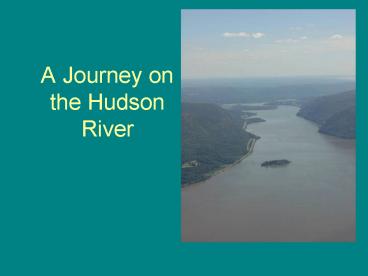A Journey on the Hudson River - PowerPoint PPT Presentation
1 / 47
Title: A Journey on the Hudson River
1
A Journey on the Hudson River
2
How long is the Hudson River?
- The Hudson River starts at Lake Tear of the
Clouds in the Adirondacks, and travels about 480
Km (300 miles) to empty into the Atlantic Ocean. - The river drains New York, and parts of
Connecticut, Vermont, Massachusetts, and New
Jersey.
3
Why is the Hudson an estuary?
4
Which part of the River do you live
in Upper Mid Lower?
5
How does the river change as you move along its
length?
- In the Adirondacks, the River is surrounded by
forest and metamorphic rocks, making the water
clear and cold.
6
What does it look like?
NYC
Albany
Cooper et al.
7
The Federal Dam at Troy halts the tidal action of
the river.
Source www.clui.org
8
As you move past the Troy dam, the river changes
dramatically.
9
(No Transcript)
10
(No Transcript)
11
(No Transcript)
12
(No Transcript)
13
(No Transcript)
14
(No Transcript)
15
(No Transcript)
16
The River is used for fishing, boating, and
recreation.
Source www.dec.state.ny.us
Source www.hrfa.net
17
Here is an example of a Hudson River food pyramid.
3 consumer
2 consumer
1 consumer
18
Where would the Atlantic Sturgeon fit in our food
pyramid?
19
Biodiversity abounds throughout the watershed.
20
(No Transcript)
21
Least Bittern Photo Credit Alan W. Wells
Least Bittern
Photo Credit Alan W. Wells
22
American Goldfinch Photo credit Alan W. Wells
American Goldfinch
Photo Credit Alan W. Wells
23
Wood Duck Photo Credit Alan W. Wells
Wood Duck ?
Photo Credit Alan W. Wells
24
Water flea
25
(No Transcript)
26
Tides are constantly changing the nature of the
river.
At low tide in Peekskill, NY
27
and at high tide!
28
Location of the salt front change depends on?
29
The Hudson River is an important habitat for
diadromous (di two, dromous direction) fish,
which migrate between fresh and marine waters.
American Eel
Atlantic Sturgeon Rob Ann Simpson
White perch
30
As an estuary, it is very productive
31
What controls primary productivity in the Hudson?
- River flow too much water
- Light not enough, and they cant grow
- Predators grazers
- Every part of the food web will have different
controls
32
Whats in the water? A lot of mud.
33
Although the health of the Hudson River has
improved in the last 40 years, problems remain.
Source www.epa.gov
Source www.filthyimages.com
34
Development pressures are changing the landscape
along the river from large single-family homes
Source www.scenichudson.org
35
to condominium development projects in wetland
areas
Source www.scenichudson.org
36
to housing development projects.
Source www.scenichudson.org
37
Chemicals called PCBs (polychlorinated
biphenyls), which cause cancer and other health
problems, were released into the Hudson River
starting in the 1950s by GE.
PCB cleanup has begun at Fort Edward, about 40
miles north of Albany. The project is expected
to remove about 10 of the contaminated river
sediment.
Source dnr.wi.gov
38
Invasive species, such as the water chestnut seen
below, have changed the ecosystem.
39
Water celery is the native species that is being
replaced along shorelines by water chestnut.
40
Zebra mussels have spread rapidly in the Hudson
since their introduction around 1985.
41
Sept 90- June 91
1992
Sept 91 Dec 91
42
Population growth of zebra mussels from 1991-2002.
43
Many scientists are working to learn more about
the river. For example, scientists at Lamont
Doherty are mapping the bottom of the river to
learn more about sediment transport and the
rivers history.
Source F. Nitsche
44
Scientists at the Cary Institute of Ecosystem
Studies are working on invasive species in and
around the Hudson River.
45
(No Transcript)
46
They also study nutrient budgets, and look for
changes over time in different habitats along the
river.
47
You will be researching the Hudson as well!































